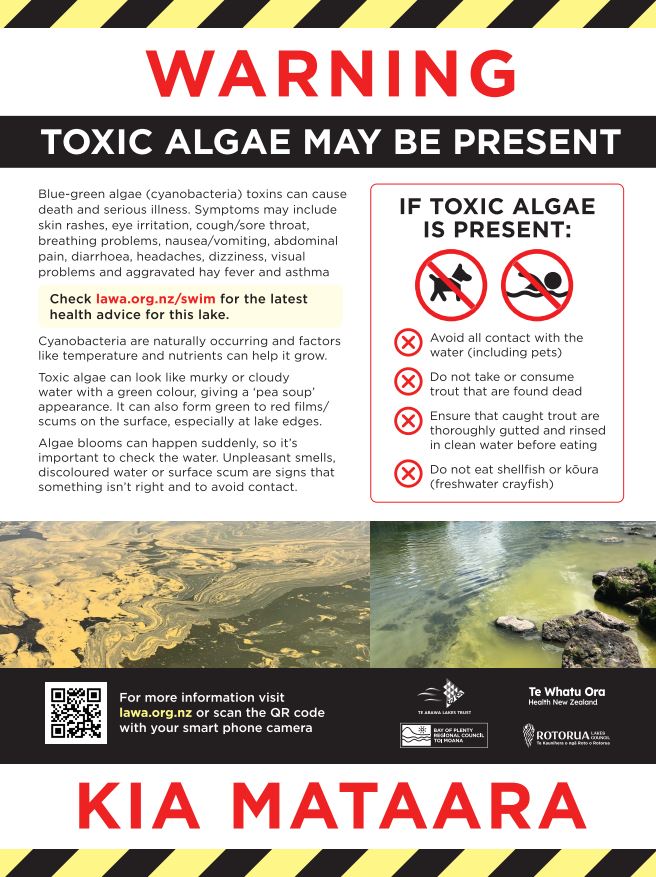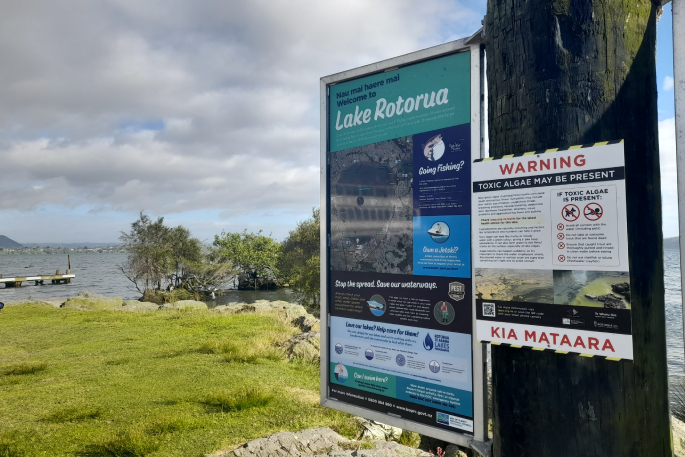The temperature outside is increasing and so is the likelihood of algal blooms in local lakes.
That’s why Rotorua Lakes Council, in partnership with Te Arawa Lakes Trust, Te Whatu Ora Health New Zealand and Bay of Plenty Regional Council, is using new signs to proactively warn lake users about the risk of toxic algal blooms (also known as cyanobacteria).
More common in the warmer months, algal blooms can affect lakes and rivers and are potentially toxic for humans and pets.
The blooms can happen suddenly, so it’s important to always check the water before entering or letting dogs play.
The new signage provides information about what algal blooms look like, and the symptoms to watch out for if you suspect you or a pet has come into contact with toxic algae.
While toxic algae may not be present, the signs will remain in place as permanent education at more than 40 lakeside locations around the district.
Should toxic algae be identified through testing, an official warning will be issued by Toi Te Ora Public Health and will be shared online by Toi Te Ora and Rotorua Lakes Council.
Suspected toxic algal blooms should be reported to Toi Te Ora Public Health on 0800 221 555.
 New warning signage in place at Rotorua lakes.
New warning signage in place at Rotorua lakes.
Latest update from Toi Te Ora - Public Health:
Check the water for algal blooms before using lakes and rivers this summer
During the warmer months, there can be potentially toxic blue-green algae present in our lakes and rivers. There is reduced capacity to monitor for algal blooms over the Christmas and New Year period, so it’s important to know the signs of algal bloom to reduce your chances of becoming unwell.
“Algal blooms can develop rapidly and unpredictably and can sometimes produce toxins that are harmful to people and animals,” says Dr Gregory Evans, Te Whatu Ora Medical Officer of Health for Toi Te Ora Public Health.
Dr Evans suggests avoiding contact with the water if it looks discoloured, has an unusual smell, has green or brown particles suspended in it, or if scum or leathery mats of algae are on the surface or the bottom of the waterway.
“These blooms have the capacity to release toxins into the water which can cause skin rashes, stomach upsets and visual problems for anyone who has contact with the water. They can also affect the nervous system causing numbness, difficulty with breathing, and asthma attacks.”
 There's lots to be aware of when enjoying our local lakes.
There's lots to be aware of when enjoying our local lakes.
Lakes are typically dominated by free-floating algal blooms, while rivers are more prone to algal blooms that grow in mats attached to rocks at the bottom. They can also build up at the shoreline.
“Algal mats and scum can build up along the edges of lakes or rivers. It’s important parents ensure children avoid contact with these as they may be toxic.”
If you think you’ve been in contact with an algal bloom; shower and change your clothes as soon as you are able to, even if you don’t have any symptoms. You should seek medical advice from your GP if you become unwell after having contact with recreational water.
Dogs are also at risk of serious illness if they consume or have contact with toxic algae or algal mats that accumulate in and around rivers. They should be kept away from the water if it looks like there may be a bloom.
There are currently health warnings in place due to algal blooms for Lake Ōkaro, Lake Maraetai and Lake Ohakuri.
Find information on local health warnings on the following channels:
- List of health warnings - Toi Te Ora Public Health website
- Follow Toi Te Ora social media channels at Facebook, Instagram, and X
- Signage at locations (erected by local councils)
- Land, Air, Water Aotearoa website



0 comments
Leave a Comment
You must be logged in to make a comment.